Is the Crypto Market Booming or Maturing?

The views expressed here are the author's own and do not necessarily represent the views of Cointelgraph.com
2017 was a breakthrough year for the crypto market for major coins such as Bitcoin, Ethereum, and Ripple, increasing awareness by the mainstream market, and innovative new applications of Blockchain technology drove impressive returns. More importantly, this blistering pace for the entire ecosystem is being driven by increasing appetite on the side of investors, with no sign of abating.
The breakneck speed at which the crypto market has expanded over the past year has not been without its hiccups and a fair share of skeptics. For many veterans, the current craze for cryptocurrencies resembles the madness of the late 90s and the heyday of the Dot-com bubble.
Trading volatility over the past few months hasn't helped the rising voices of speculation. That Bitcoin crashed by nearly half its value in a single day, or that this isn't the only similar incident, prove that massive price swings are still a major concern, and the market is incredibly unstable. Others, however, counter that even if the industry were to face a bubble, it could lead to a more mature and innovative market.
David Stockman, Ronald Reagan's former director of the Office of Management:
It's basically a class of really stupid speculators who have convinced themselves that trees grow to the sky. It will burn out in a spectacular crash. All of these latter-day speculators will have their hands burned to a crisp, and they will learn the proper lesson."
As pretenders are weeded out, observers argue that the sector will stabilize, and continue expanding at a more measured pace.
Jeffrey Kleintop, chief strategist of Charles Schwab:
"...I think the Bitcoin bubble if you want to call it that, is something different. If Bitcoin prices were to plunge suddenly, because it's so independent from the financial system, it's kind of its own thing. It hasn't yet become embedded in the economy and the financial structure."
Even so, the debate is not entirely black-and-white. The crypto ecosystem has shown signs of being in a bubble-disproportionate valuations for companies without actual products, an alarming rate of new ICOs, increasing numbers of scams and failed launches- but has also shown signs of a more stable future.
Marianne Lake, chief financial officer at JPMorgan:
"We are very open-minded to the potential use cases in future for digital currencies that are properly controlled and regulated."
Major coins such as Bitcoin and Ethereum are slowly entering the financial mainstream as traditional exchanges increasingly offer related instruments, and merchants begin to accept more cryptocurrencies as payments. Nevertheless, the question remains a valid one - is the crypto market simply booming or is it finally growing up?
Riding out the boom
There are several indications that the crypto ecosystem could be in the midst of a massive bubble. The situation has repeatedly been compared to the Dot-com bubble, and in some cases, the similarities are plain to see. Driven by the excitement of a new, potentially revolutionary technology, investors ponied up millions in funding to companies that promised the sky but largely failed to deliver anything.
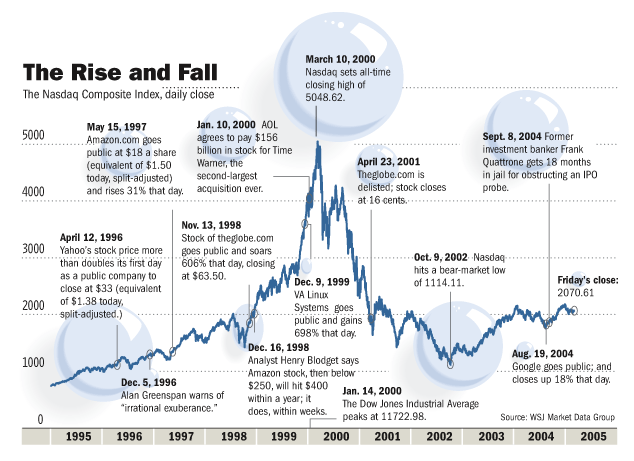
The Dot-com bubble [Image: Business Insider]
The 90s were about the rise of the Internet, and the current market is based around Blockchain, the architecture underlying most cryptocurrencies. The market capitalization for cryptocurrencies continues to hover closer to the $1 tln mark, despite wild swings that have pushed it between $700 and $800 bln over the past few months.
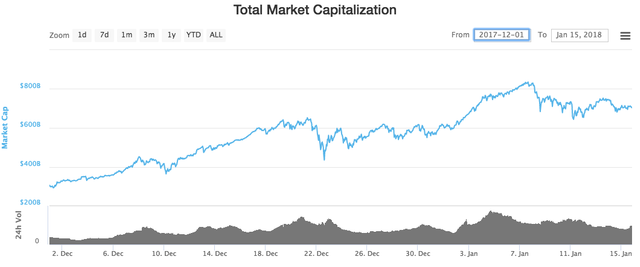
Image: Coinmarketcap
Moreover, the current boom in crypto valuations has been driven in large part by a completely unregulated ecosystem. It seems to reward the flashiest assets, even when their practical applications may be dubious at best. This is clear in the outsized capital many Blockchain-based companies have raised. In the second quarter of 2017 alone, ICOs raised nearly $800 mln in funding, with the first six months yielding $1.3 bln in capital.
Individually, the largest cryptocurrencies have all reached valuations that were not even contemplated just one year ago. Bitcoin, the first and largest cryptocurrency by market capitalization, has soared over 1,700 percent in the last 12 months, skyrocketing from slightly over $800 to nearly hit $20,000 before settling lower.
Bitcoin Cash, Litecoin and Ethereum have all seen similar trajectories in 2017, and indications point to continued growth. The signs of a bubble are there, and this current boom seems unsustainable. However, the reality may prove slightly different, for a variety of reasons. Recent volatility across the board, led by a crash in Ripple"s valuation following South Korea's alleged announcement for a cryptocurrency trading ban, shows that the industry is susceptible to massive swings.
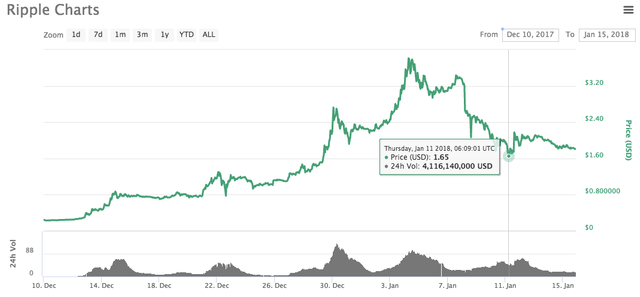
Image: Coinmarketcap
Even so, dips have historically been followed by upward corrections over recent months, showing the market's staying power.
A more mature crypto market
Even as cries of a bubble get louder, the crypto market has actually trended in the direction of maturation. For one, governments are starting to recognize cryptocurrencies potential and embrace them in some ways. Japan recognized Bitcoin as a legal payment method in 2017 as well as certifying several cryptocurrency exchanges to operate within its borders. Russia announced plans to create its own cryptocurrency, the CryptoRuble, and even Venezuela has revealed plans to launch its own coin.
Others have started to regulate the crypto market, offering hope that increased stability will lead to greater adoption. The EU and several Asian countries have enacted new laws to bring some order to the market. Even in the US, major exchanges have started offering Bitcoin futures as tools for more institutional investment participation.
Dennis Gartman, economist and commodity analyst, The Gartman Letter editor:
"It [cryptocurrency] is gaining some sense of legitimacy by the Cboe.
...When they [cryptocurrencies holders] begin to pay taxes on it, when it ceases to be an avenue for avoiding taxes, when it ceases to be a place where drug dealers are trading and making transactions, then I'll be interested."
More importantly, however, businesses and entrepreneurs have embraced Blockchain, the market's underlying technology, creating a thriving ecosystem of applications and services.
Companies are finding better ways to utilize Blockchain's capabilities, instead of relying on cryptocurrencies' speculative gains. Already, several companies have introduced solutions that improve on several traditional business activities, from creating better agreements - companies such as Jincor, which offers simple smart contract creation -to giving consumers better access to services like financing and cloud storage. Blockchain startups like Cryptopay are facilitating payments with cryptocurrencies, while others like SelfKey are focused on creating better forms of identification for individuals. Moreover, in the financial sphere, businesses like Legolas are improving wealth management and investment platforms.
These applications are quickly gaining popularity, and new companies are finding diverse ways to migrate their services to this architecture. However, many have natural barriers, as Blockchain requires a new round of development and hires.
Currently, most companies still rely on Ethereum's ERC-20 protocol and smart contracts to build new applications, but that paradigm is still dev-heavy. Instead, some companies have already shown better pathways to developing Blockchain-based apps.
This nascent sector has already shown promise, and new applications are further expanding the ecosystem. Qtum, for example, provides a hybrid infrastructure for developers to build Blockchain applications that are suitable for operating with the major Blockchains, while also compatible with mobile and IoT services. The company's dual architecture is based on Bitcoin Core and Ethereum Virtual Machine to allow for the use of smart contracts across platforms. The end-deliverable is a lighter-weight product with cross-chain functionality that outmatches Ethereum's capabilities while broadening Blockchain's appeal. The company has shown significant promise and caught investors' attention, rewarding the valuation with a near 200 percent leap higher in December 2017.
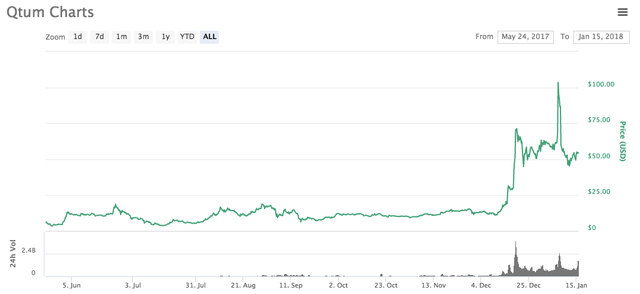
Image: Coinmarketcap
Most importantly, however, cryptocurrencies are beginning to find real use cases. Ripple has been successful in carving a niche in banking and business-to-business transactions. Bitcoin Cash promises to solve many of Bitcoin's shortcomings as a payment method, namely scaling and transaction speed. Meanwhile, Ethereum has proven its worth as an infrastructure for application development.
Even with the high volatility in the cryptocurrency market, the overarching trend in 2017 has been overwhelmingly positive. As the industry becomes more widely accepted, it could help significantly stabilize the recent wave of volatility.
2018 could be promising
There are signs that the crypto market is still rather unstable, including sky-high valuations and a rapid pace of growth that has rivaled manias of the past, but 2017 still closed on a strong note.
However, success in the next year will rely heavily on broader adoption. And a market that can withstand speculation waves. Should Bitcoin valuations remain highly volatile, investors and exchanges will eventually be scared off, and trading may decrease. The recent extreme swings experienced by the broader market highlights how precarious the current boom is.
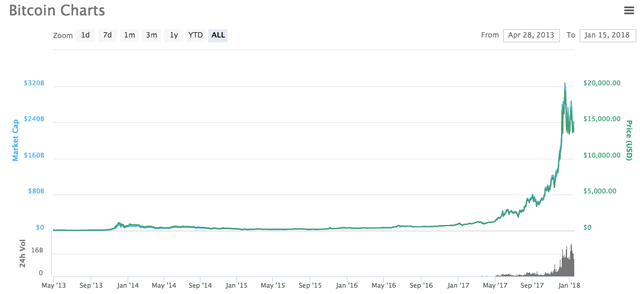
Chart showing the Bitcoin price movement since 2013
2018 is promising to be a momentous year for the industry. As fears of a bubble collapse increase, many are looking at it optimistically. In their eyes, the ecosystem is ripe for a cleaning, and removing underperformers and unsustainable projects could enable the real contenders to grow. Moreover, a wave of consolidation and the entry of institutional investment into the sphere could lead to broader adoption and a more stable market.
Though the crypto market is growing, it must show sustainability and deliver better fungibility. As more companies demonstrate effective uses for cryptocurrencies and Blockchain technology, the overall ecosystem should continue to stabilize and expand as awareness of its inherent benefits improves.
Content adapted from this cointelegraph.com article : Source
Disclaimer : Account @coin-telegraph is not affiliated with cointelegraph.com. I read Cointelegraph multiple times a day to find the best articles and reformat them for Steemit. I appreciate the upvotes but consider following the account and resteeming the articles that you think deserve attention instead. Thank you! Head over to Cointelegraph.com for a more complete news coverage about what affect the economy, geopolitics & cryptocurrencies.